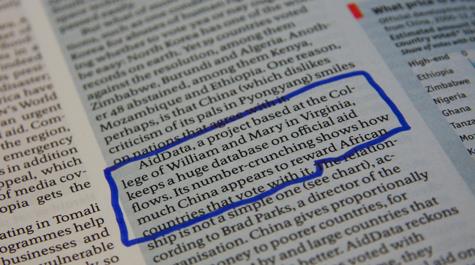The Economist, other news outlets highlight work by W&M researchers
Work by the university’s researchers has been prominent in the national — and even the international — media recently.
William & Mary’s AidData collaborative provided the database that fueled “A despot’s guide to foreign aid.” The article, which appeared in April 16 edition of The Economist, outlines some interesting links between United Nations votes cast by African nations and the dollar amount of aid those nations received from China.
Correlation doesn’t imply causation, as any good researcher knows, and Brad Parks, co-executive director of AidData, advised The Economist that the relationship between a nation’s vote in the United Nations and the amount of aid it receives is not simple. But the London-based newsmagazine used AidData’s mammoth records on the flow of foreign aid to show that Beijing “appears to reward” African countries that follow along with China’s votes in the UN.
“China gives proportionally more money to poorer countries, for instance,” the analysis on page 40 reads. “But by and large countries that support China do better. AidData reckons that if African countries vote with China an extra 10% of the time, they would get an 86% bump in official aid on average.”
The same issue also contained a page 67 profile of Sonic Nets, a method to discourage birds from gathering in places where birds are a nuisance or a danger. Sonic Nets is a William & Mary collaboration headed by Mark Hinders, professor of applied science, and John Swaddle, professor of biology. Sonic Nets operates on the disruption principle, using speakers to issue sounds that overlap the acoustic frequencies of the bird calls.
The Economist article, headlined “Sonic scarecrow,” highlights Sonic Nets’ potential for increasing air safety by keeping runways clear of birds, although the technology also be used to keep birds from parking areas, fields of ripening crops, etc. The piece noted experimental successes of Sonic Nets, including trials in the William & Mary aviary and at an airfield.
Sonic Nets also was featured in a Forbes piece headlined “Acoustic Scarecrows: A Humane, Non-Lethal Way To Reduce Bird Strikes.” The article points out the potential savings of a bird deterrent like Sonic Nets, citing figures that put the damages to civil and military aircraft due to bird strikes at nearly $1 billion.
A recent piece spotlighting William & Mary research that first appeared on the front page of the Daily Press was picked up by the Associated Press and has grown legs. Daily Press science writer Tamara Dietrich interviewed Laurie Sanderson, a professor in the Department of Biology, on her efforts to design an industrial filtration system based on the anatomy of filter-feeding fish.
Dietrich’s story appeared in a number of AP-member media outlets, including The Richmond Times Dispatch and The Washington Post.















